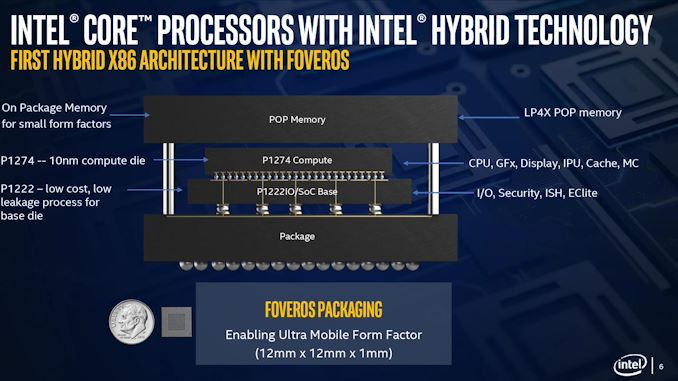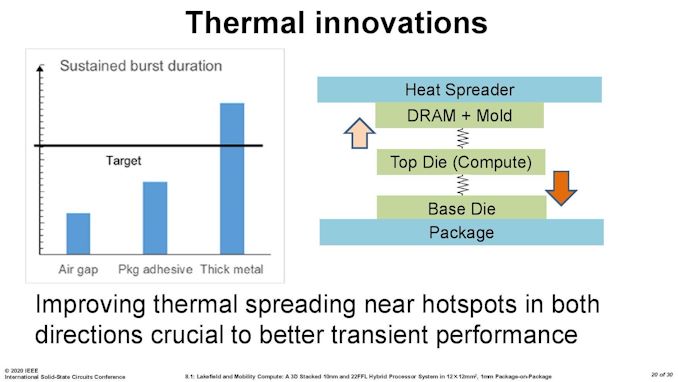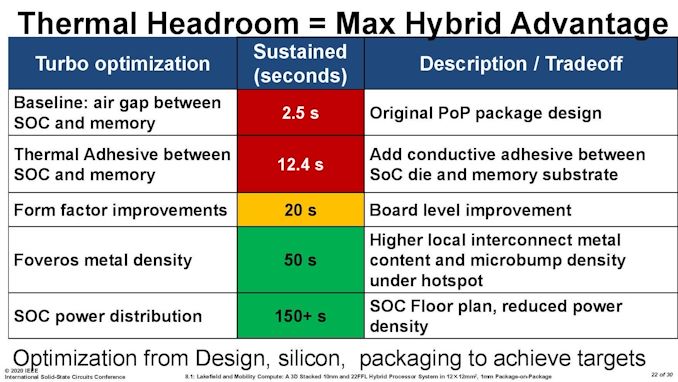The Intel Lakefield Deep Dive: Everything To Know About the First x86 Hybrid CPU
by Dr. Ian Cutress on July 2, 2020 9:00 AM ESTThermal Management on Stacked Silicon
With a standard processor design, there is a single piece of silicon doing all the work and generating the heat – it’s bonded to the package (which doesn’t do any work) and then depending on the implementation, there’s some adhesive to either a cooler or a headspreader then a cooler. When moving to a stacked chiplet design, it gets a bit more complicated.
Having two bits of silicon that ‘do work’, even if one is the heavy compute die and the other is an active interposer taking care of USB and audio and things, does mean that there’s a thermal gradient between the silicon, and depending on the bonding, potential for thermal hotspots and build-up. Lakefield makes it even more complex, by having an additional DRAM package placed on top but not directly bonded.
We can take each of these issues independently. For the case of die-on-die interaction, there is a lot of research going into this area. Discussions and development about fluidic channels between two hot silicon dies have been going on for a decade or longer in academia, and Intel has mentioned it a number of times, especially when relating to a potential solution of its new die-to-die stacking technology.
They key here is hot dies, with thermal hotspots. As with a standard silicon design, ideally it is best to keep two high-powered areas separate, as it gives a number of benefits with power delivery, cooling, and signal integrity. With a stacked die, it is best to not have hotspots directly on top of each other, for similar reasons. Despite Intel using its leading edge 10+ process node for the compute die, the base die is using 22FFL, which is Intel’s low power implementation of its 14nm process. Not only that, but the base die is only dealing with IO, such as USB and PCIe 3.0, which is essentially fixed bandwidth and energy costs. What we have here is a high-powered die on top of a low powered die, and as such thermal issues between the two silicon die, especially in a low TDP device like Lakefield (7W TDP), are not an issue.
What is an issue is how the compute die gets rid of the heat. On the bottom it can do convection by being bonded to more silicon, but the top is ultimately blocked by that DRAM die. As you can see in the image above, there’s a big air gap between the two.
As part of the Lakefield design, Intel had to add in a number of design changes in order to make the thermals work. A lot of work can be done with the silicon design itself, such as matching up hotspots in the right area, using suitable thickness of metals in various layers, and rearranging the floorplan to reduce localized power density. Ultimately both increasing the thermal mass and the potential dissipation becomes high priorities.
Lakefield CPUs have a sustained power limit of 7 watts – this is defined in the specifications. Intel also has another limit, known as the turbo power limit. At Intel’s Architecture Day, the company stated that the turbo power limit was 27 watts, however in the recent product briefing, we were told is set at 9.5 W. Historically Intel will let its OEM partners (Samsung, Lenovo, Microsoft) choose its own values for these based on how well the design implements its cooling – passive vs active and heatsink mass and things like this. Intel also has another factor of turbo time, essentially a measure of how long the turbo power can be sustained for.
When we initially asked Intel for this value, they refused to tell us, stating that it is proprietary information. After I asked again after a group call on the product, I got the same answer, despite the fact that I informed the Lakefield team that Intel has historically given this information out. Later on, I found out through my European peers that in a separate briefing, they gave the value of 28 seconds, to which Intel emailed me this several hours afterwards. This value can also be set by OEMs.
Then I subsequently found one of Intel’s ISSCC slides.
This slide shows that a basic implementation would only allow sustained power for 2.5 seconds. Adding in an adhesive between the top die and the DRAM moves up to 12.4 seconds, and then improving the system cooling goes up to 20 seconds. The rest of the improvements work below the compute die: a sizeable improvement comes from increasing the die-to-die metal density, and then an optimized power floor plan which in total gives sustained power support for 150+ seconds.













221 Comments
View All Comments
Spunjji - Monday, July 6, 2020 - link
Given the cost of producing multiple dies, stacking them, and packaging the whole lot with RAM on top - I doubt even that's going to be particularly compelling. It probably would have been better if they'd transitioned fully to 10nm and had idle 14nm capacity, but as it stands this will be competing for manufacturing space with their own premium products on both lines. D:lmcd - Friday, July 3, 2020 - link
This isn't designed for Windows. This is designed for Windows 10X. Windows 10X got delayed so partners are shipping it with Windows.serendip - Friday, July 3, 2020 - link
Will Win10X bring a magical doubling in performance?Spunjji - Monday, July 6, 2020 - link
My thoughts exactly. I feel like they've tried to do too many things at the same time with this product.They obviously wanted to demonstrate Foveros with a relatively low-complexity, relatively low-power chip - but the cost of the first-gen Foveros tech conflicts with one of the big primary selling points of small chips in the first place, i.e. lower cost. So they've gone for a "premium" product, but the first-gen Foveros tech puts a fairly low ceiling on its performance - meaning it's not actually very premium in practice.
It's a quagmire of mutually contradictory requirements, and tbh that's pretty on-par with Intel's previous efforts in the low-power CPU arena.
lmcd - Thursday, July 2, 2020 - link
Honestly confused why everyone is up in arms about the lack of AVX. This is a tablet SoC for Windows 10X and any other usage of it is outside of its intended scope. Future SoCs might add more of this functionality but it doesn't really seem like a priority. A low-power SoC that also won't wilt to the render thread and "just works" with legacy x86-only apps when necessary sounds good to me.Spunjji - Monday, July 6, 2020 - link
I think it's mainly that Intel have spent so much time selling that feature so hard, then dropped it - albeit without actually physically removing it. So, once again, Intel are charging their customers money to manufacture something in silicon that they can't actually use.xdrol - Thursday, July 2, 2020 - link
The Snapdragon 7c is more like a 2+6 than a 0+8 chip: It has 2x Kryo Gold (Cortex A76) and 6x Kryo Silver (A55) cores.Sychonut - Friday, July 3, 2020 - link
I am not sure I understand whether the added design complexity is justified by the very minor power savings as depicted by the power / performance graph on page 1, or am I reading it wrong? The difference between the two curves seems marginal at best below 58%.ichaya - Friday, July 3, 2020 - link
That seems like the most meaningful part of the chart. You can still deliver 60%+ performance with only 30-50% of the power.This is a 1st gen attempt and a 2+4 design with AVX and ARM's System-level cache would definitely be interesting to see in ultra portables.
unclevagz - Friday, July 3, 2020 - link
Which itself is not a good showing for the 'efficiency' core, the small thunder cores in the Apple A13 are at ~20-30% of the Lightning core's performance while consuming 5-15% of the power (2-3x perf/watt) . And the A13 Lightning in all likelihood already runs rings around the lakefield cores in this department.